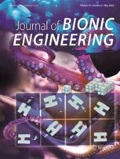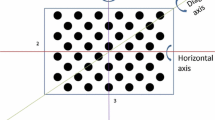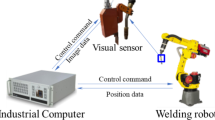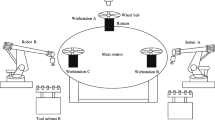Abstract
Based on photogrammetry technology, a novel localization method of micro-polishing robot, which is restricted within certain working space, is presented in this paper. On the basis of pinhole camera model, a new mathematical model of vision localization of automated polishing robot is established. The vision localization is based on the distance-constraints of feature points. The method to solve the mathematical model is discussed. According to the characteristics of gray image, an adaptive method of automatic threshold selection based on connected components is presented. The center coordinate of the feature image point is resolved by bilinear interpolation gray square weighted algorithm. Finally, the mathematical model of testing system is verified by global localization test. The experimental results show that the vision localization system in working space has high precision.
Similar content being viewed by others
References
Chen F, Brown G B, Song M M. Overview of three-dimensional shape measurement using optical methods. Optical Engineering, 2000, 39, 10–22.
Zhao J, Zhan J, Jin R, Tao M. An oblique ultrasonic polishing method by root for free-form surfaces. International Journal of Machine Tools and Manufacture, 2000, 40, 795–808.
Ishii M, Sakane S, Kakikura M, Mikami Y. A 3-D sensor system for teaching robot paths and environments. International Journal of Robotics Research, 1987, 6, 45–59.
Betke M, Gurvits L. Mobile robot localization using landmarks. IEEE Transactions on Robotics and Automation, 1997, 13, 251–264.
Cox L J. Blanche: Position estimation for an autonomous robot vehicle. IEEE/RSJ International Workshop on Intelligent Robots and Systems, Tsukuba, Japan, 1989, 432–139.
Tam H Y, Lui C H, Mok C K. Robotic polishing of free-form surfaces using scanning paths. Journal of Materials Processing Technology, 1999, 95, 191–200.
Se S, Lowe D, Little J. Mobile robot localization and mapping with uncertainty using scale-invariant visual landmarks. The International Journal of Robotics Research, 2002, 21, 735–758.
Unnes U, Faia P, de Almeida A T. Sensor-based 3-D autonomous surface-following control. Mathematics and Computers in Simulation, 1996, 41, 429–144.
Lee M C, Go S J, Lee M H, Jun C S, Kim D S, Cha K D, Ahn J H. A robust trajectory tracking control of a polishing robot system based on CAM data. Robotics and Computer — Integrated Manufacturing, 2001, 17, 177–183.
Pfister S T. Algorithms for Mobile Robot Localization and Mapping Incorporating Detailed Noise Modeling and Multi-Scale Feature Extraction, California Institute of Technology, Pasadena, California, 2006.
Marquez J J, Perez J M, Rios J, Vizan A. Process modeling for robotic polishing. Journal of Materials Processing Technology, 2005, 159, 69–82.
Ens J, Lawrence P. An investigation of methods for determining depth form focus. IEEE Transactions on Pattern Analysis and Machine Intelligence, 1993, 15, 97–108.
Lenz R K, Tsai R Y. Techniques for calibration of the scale factor and image center for high accuracy 3D machine vision metrology. IEEE Transactions on Pattern Analysis and Machine Intelligence, 1988, 10, 713–720.
Fischler M A, Bolles R C. Random sample consensus: A paradigm for model fitting with applications to image analysis and automated cartography. Graphics and Image Processing, 1981, 24, 381–395.
Tang J L. Some Necessary Conditions on the Number of Solutions for the P4P Problem. In: Lecture Notes in Computer Science: Computer Algebra and Geometric Algebra with Applications, Springer, Berlin, 2005, 3519, 56–64.
Wu Y, Hu Z. PnP problem revisited. Journal of Mathematical Imaging and Vision, 2006, 24, 131–141.
Harris C. Geometry from visual motion. In: Blake A, Yuille A (eds). Active Motion, MIT Press, Cambridge, 1993.
Author information
Authors and Affiliations
Corresponding author
Rights and permissions
About this article
Cite this article
Yang, Zj., Chen, F., Zhao, J. et al. A Novel Vision Localization Method of Automated Micro-Polishing Robot. J Bionic Eng 6, 46–54 (2009). https://doi.org/10.1016/S1672-6529(08)60104-3
Published:
Issue Date:
DOI: https://doi.org/10.1016/S1672-6529(08)60104-3




